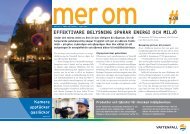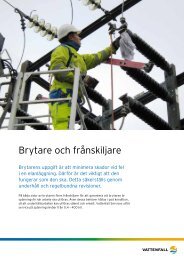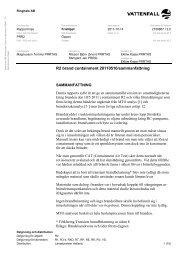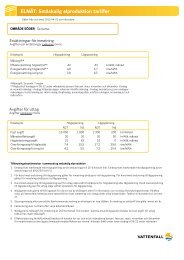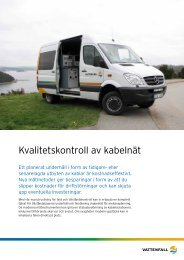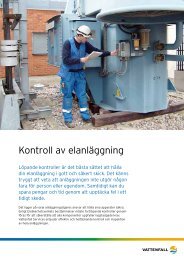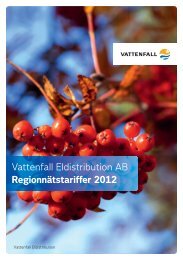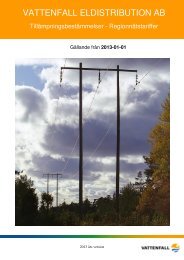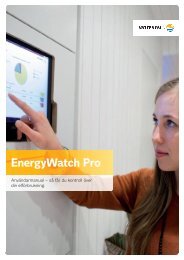This environmental impact assessment for Kriegers flak ... - Vattenfall
This environmental impact assessment for Kriegers flak ... - Vattenfall
This environmental impact assessment for Kriegers flak ... - Vattenfall
Create successful ePaper yourself
Turn your PDF publications into a flip-book with our unique Google optimized e-Paper software.
44 ALTERNATIVE LOCATIONS<br />
8. Alternative locations<br />
The sea around Sweden’s coast is sensitive and certain areas are particularly sensitive and<br />
extra worthy of protection. Due to this, the choice of location <strong>for</strong> offshore wind power plant<br />
is very diffi cult and a comparison with alternative locations is of great importance to be able<br />
to chose the location with the best advantages and that at the same time causes the least<br />
obstruction and inconvenience.<br />
In the 6th chapter, § 7 of the EC, it states that an EIS should contain an “account of alter-<br />
native locations, if these are possible, and alternative solutions together with the motivation<br />
of why a certain location has been chosen”. Due to this a site study has been made and is<br />
presented below.<br />
8.1 Important criteria <strong>for</strong> choice<br />
of location<br />
The criteria that are important <strong>for</strong> choice of location<br />
are presented below.<br />
a) Offshore-based<br />
The area should be offshore. The advantage of building<br />
wind power offshore is primarily that there is more<br />
wind in comparison to onshore, the wind energy per<br />
square meter can be up to 40 % higher than onshore.<br />
Offshore wind power is also less intrusive on the landscape<br />
as turbines are placed far from the closest buildings.<br />
Offshore wind farms also allow the advantage of<br />
having larger farms built. <strong>This</strong> is due to the fact that<br />
larger areas can be claimed and that the transport of<br />
large components, such as rotor blades, is easier at sea.<br />
b) Within Sweden’s borders<br />
As the energy being delivered is going to Sweden it is<br />
required that the area is within the territorial border or<br />
within Sweden’s economic zone.<br />
c) Scope<br />
The area should be large enough to allow a large<br />
number of wind turbines <strong>for</strong> the project to be Þ nancially<br />
proÞ table. The number of wind turbines needed<br />
<strong>for</strong> Þ nancial proÞ tability depends among other things<br />
on the cost of the plant at the location, which in turn<br />
depends on water depth, seabed conditions etc. A very<br />
important factor is the cost of the grid connection that<br />
will be very high if the area is far from the shore. For a<br />
normal wind power project the cost <strong>for</strong> grid connection<br />
seldom exceeds 7-10% of the total cost of the project<br />
but <strong>for</strong> a project based far out at sea, such as <strong>Kriegers</strong><br />
Flak, the cost is 13-15%. <strong>This</strong> is due to the fact that 1<br />
km of sea cable is approximately Þ ve million SEK. In<br />
other words, when building offshore wind power you<br />
need to build a relatively large amount of turbines and<br />
thereby claim a large area in order to Þ nance the grid<br />
connection.<br />
d) Water depth<br />
Offshore wind farms should be built at a depth between<br />
10 and 40 meters. If built deeper than 40 meters





